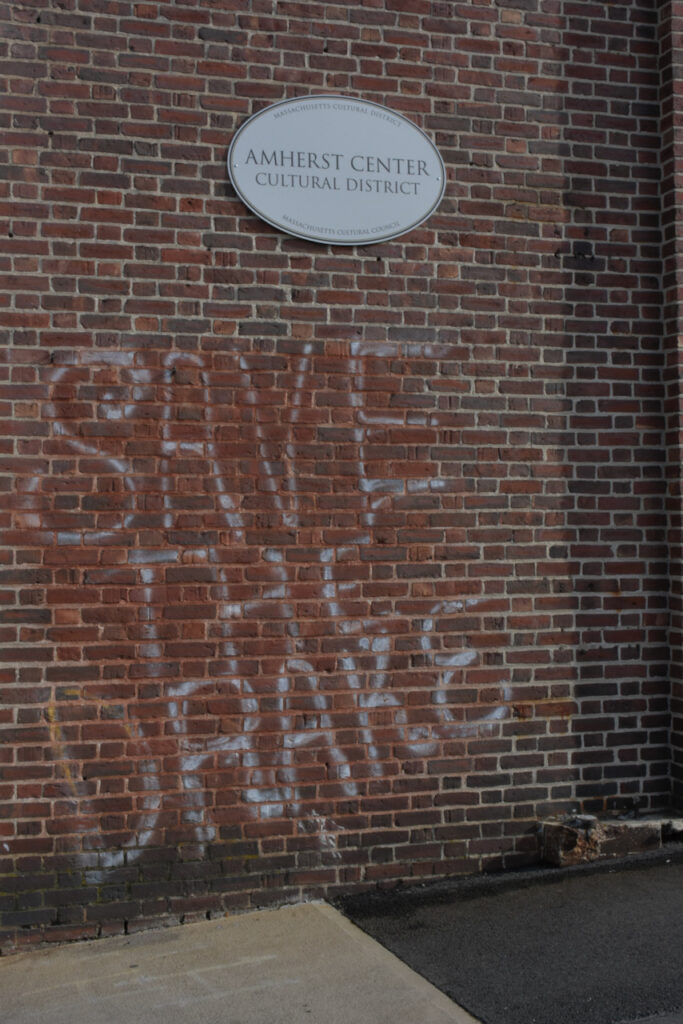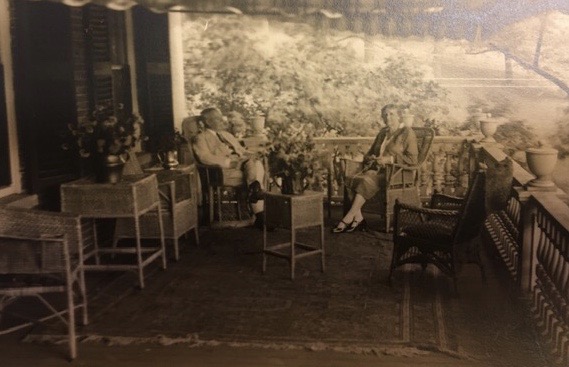The Original Drake

The new Drake nightclub, 44 North Pleasant Street, Amherst. Photo: amherst.edu
Amherst History Month by Month
Editor’s note: All the images below from the Jones Library and branches Special Collections are used with permission.

This past weekend, I went in search of the story behind The Drake, Amherst’s downtown nightclub at 44 North Pleasant Street. Like many people, I’ve always been curious about the related graffiti that is still on the side of Amherst Coffee. Its dramatic tone declares “Save the Drake” and “For Willy. For Humanity.” This refers to the time when the Drake, a popular bar, rathskeller, and live music venue, was scheduled for closing, which took place in 1986. The graffiti was signed DLF for the Drake Liberation Front, the appellation adopted by the protesting duo who contributed the graffiti the night before the original Drake closed. As it turns out, the Drake’s supporters left their plea on one of the oldest buildings in town, a stable block for the horses that had once pulled the local trolley services around here. But I am getting ahead of myself.
The Drake started life in the basement of a large old house at the top of Amity Street, just around the corner from North Pleasant Street. This c. 1860 house had been built in the Greek Revival style, which makes it quite a late example of this popular American Revival style, and was successively home for the Spear, the Marsh, and the Perry families. By the end of the 19th century, in 1898, it had become a boarding house. Mr. and Mrs. Perry and their residents enjoyed its expansive porches and central location. In 1903, they named it Prospect House because of its commanding views of Amherst center as well as the broad expanse of Hadley’s fields and hills. Creating a bar was not in anyone’s sights at this time.


The Perrys renovated the structure in 1912 and then, just as the Americans entered World War I, in 1917, they added two floors and re-named it Hotel Perry, a riff on more venerable Parisian residences from the era of the Renaissance. But in line with new styles in America, the changes were in the Colonial Revival style, to fit in perhaps with the original house.

The Perry family produced a fancy brochure with descriptions and photos of the available rooms, as well as the dining hall, library,porch and other amenities for prospective boarders and summer guests.

Business remained decent and in 1938 the Perrys sold the property to the Richters, who renamed it Drake’s Hotel. The Richters hoped to draw visitors from near and far, including visitors whose children were students at Smith College, Mount Holyoke College, Amherst College and what was then the Massachusetts State College (previously Massachusetts Agricultural College).

In 1943, Drake’s began to serve “Wine and Liqueurs” in a rathskeller (the German word for a basement tavern, often found in city halls) in addition to their regular dining room menu. In 1955, they advertised a special Thanksgiving dinner for $2.75 per person, although the meal it was known for until it closed was steak and fries.

Interestingly, the building by this time was owned briefly by Lincoln Realty (now Lincoln Management Company) and then, in 1959, Pat Kamins became the owner, furnishing the property with a new lease on life and another new name, Drake’s Village Inn.

Entrance to the basement bar of the Village Inn. PhotoL Jones Library Special Collections
The rathskeller became a popular venue for UMass and Amherst College students, and was seen as “the” place to go for a student’s first legal drink. The UMass magazine from 1998 quotes Jim Foudy, Class of ’68 (who retired in 2013 from being publisher of the Daily Hampshire Gazette) as saying that the Drake bar had been “sophisticated, funky, a little exotic.” The scene was not like a college frat or a club in town but more unusual. “It was a place where you saw people you wouldn’t see on campus — black people, artists.” Managing it all was its longtime bartender or barkeep — Willie Whitfield — the Willy of the graffiti that is still on the walls of the Amherst Coffee building.
This didn’t necessarily sit well with the Amherst Historical Society, whose Strong House is across North Prospect Street from the old Drake’s entrance. They brought their issues to the town’s select board and asked that something be done to prevent the historic character of the area from eroding, and perhaps impacting nearby streets. It was not uncommon for young people to gather on the sidewalks by the Drake, the Strong House, and the Jones Library after having a few drinks at the Drake.

The help of local architects Tullio Iglese and Peter Kitchell, Sr. was obtained between 1980 and 1985 to make further alterations to the building, and the Drake was closed to the public. Iglese went on to form TIA Architects, based at the NACUL Center, and both architects deserve much more said about them than is possible in this column.
Today the building is still managed by Kamins and has a variety of rental units available. The upper floors confirm the good “prospects” and the first-floor units are said to be especially nice, with the original furnishings of the hotel.

My family recounts tales of sticking to the floor there while waiting for the Vietnam draft
Please don’t allow Willy Whitfield’s name to be removed by some do-gooders who don’t know the history of the ORIGINAL and ONLY REAL Drake or have any real connection to it. Friends of mine frequented, lived and even some passed away in there. Willy was a great bartender, even his son lived there at one point in the middle 70’s. It holds a special meaning for those of us who grew up in Amherst and those memories cannot be erased by moving into a new space and calling it The Drake. One original that cannot be copied!
Allegra – in one sentence, you capture vividly the qualities of that era!
As per the second comment, I was told that the developer for this building (when it became the Amherst Cinema, etc) made sure that the graffiti was saved (although whether or not they wanted to save the original Drake is not known?) I hope there are more people (here in the Comments) who recall this historic and popular place in Amherst. In the 1970s I was familiar with pubs with sticky floors and even some tables – a long way from Amherst though!
The Drake was still going strong in the ’80s when I started hanging out there after a hard day’s work. The atmosphere was most always upbeat but, being a bit of a loner, I also enjoyed the view from the downstairs bar out the side of the building where, amongst the shrubs, birds and other critters hung out. So, there was wildlife at The Drake both inside & out.
BTW, my son was at ARHS at the time and had a wild friend who claimed to be one of the graffiti “artists” who memorialized The Drake. The Drake presente’
Thanks for writing this, Hetty. I think that many long term Amherst residents will appreciate the article.
The Drake was widely known as the place to go for inexpensive beer and lax age enforcement in the late 1970’s. I recall small pitchers complete will clear plastic glasses, priced at $1.90 or thereabouts, in 1978 or 1979. The drinking age was 18 or 19 at the time and rising on the way to 21 in a stepped annual manner, due to state legislation. There was a large block lettered message in dark blue spray-paint on the sidewalls as one descended into the “Drake” (Rathskeller), that read “B-21 or be gone”. A clear warning that was ignored by many.
My grandparents lived nearby at the intersection of Prospect Street and Cowles Lane. I recall being slightly intimidated while in grade school, by the entrance to the Drake (as in the classic horror movie refrain “Don’t go in the basement!”). The upstairs establishment was much less crowded and had a different type of intrigue, with limited lighting and dark red decor throughout. It and was clearly targeted towards a different audience and purpose, than the basement scene.
The Drake is definitely a part of Amherst history with many iterations through the generations. Perhaps the AHS and Strong House will include a photo in acknowledgement to the infamous prior establishment that was located within the walls of a neighbor, all those years ago 🙂
If only Amherst College had been a bit “swifter” back in the winter of 1976-77, I too might have had some tales to tell of The Drake. The fond comments above hint at why there might not be many photos commemorating its interior — could such a place exist in the era of selfies and social media? — but maybe more photos will come out of the woodwork now that statutes of limitations have long expired ;-)!?
The Drake in the early 80’s had a bit of an outlaw air to it. I decided to give it a try and walked over from my dorm at Umass. I sauntered into the upstairs lounge, not realizing the basement bar heavily populated by students was even there for some weeks or months.
Upstairs was a slice of heaven if your idea of heaven is 50 kinds of beer on tap, decent and very inexpensive Mexican food, a smoking hot jukebox making a joyful noise and a pool table with some really good players.
All kinds of people were welcome as long as you were willing and eager to get along with everyone.
I had moved away when I heard the Drake had closed. That was a sad day for me.
After I moved back to Amherst four years later the graffiti on the Amherst Cinema building made me smile when I drove by. Coming up on forty years later, still does.